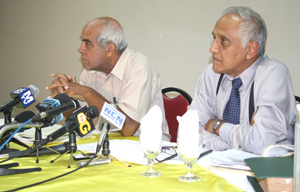Amaila Project over priced by 40%
-Govt. guaranteeing 82% of monies for 40% stakes
“…no self-respecting executive would take a deal structured similar to the hydro to its Board of Directors for approval”- Gaskin, Ram
Two financial experts have expressed alarm over the structure of the current Amaila Falls hydro electric deal, yesterday warning that there is no guarantee tariffs will not raise once the facility is in operation.
Both Christopher Ram and Ramon Gaskin also questioned the rationale behind the decision to allow the developer, Sithe Global, a 60 per cent stake in the company managing the hydro facility despite Guyana putting up or guaranteeing almost 82 per cent of the funding for the project.
The total costs of the project will over the 20 years cost Guyanese US$2.4B, monies that will be spent in unclear circumstances.
The concerns of both Ram and Gaskin were heightened when the government cancelled a key sitting of the National Assembly today to conduct a meeting with stakeholders and politicians in a move to attract support for the project.
Last Thursday, the Opposition voted down two Bills, including one to raise the country’s debt ceiling to $150B. Government immediately said that the development has jeopardized the project and probably would push back its construction by at least five years.
Take it to the Board
During a presentation yesterday at the Georgetown Club, Gaskin and Ram made it clear that no self-respecting executive would take a deal structured similar to the hydro to its Board of Directors for approval.
Gaskin said that from estimations, the project can be built and owned by Government for between US$350 and US$400M, far below the tag price of US$840M.
As it is now, there is still a lot of information that is not available to exactly assess the deal in its entirety.
Gaskin said that there are many things wrong with no indications that Guyana allowed competitive bidding that opened the project to contractors. China Railway First Group has been awarded a US$506M project to build the facility and hydro dam at Amaila Falls, Region Eight.
The difference between the US$506M and the US$840M tag price is said to be interests, financing costs, risk insurance and advisory fees, among other things.
Regarding statements from the government that the project is cheap and provide reliable power, the indications are to the contrary, Gaskin argued.
Compared to Uganda’s Bujugali hydro electric project in which a 250 megawatts facility cost US$900M, at about US$6M per megawatt, the Amaila Falls project will cost about 40 per cent more despite the latter being a 165 megawatts of power. Sithe Global was also a major player in the Bujugali project.
19% interest rate
Also questioned by the two men, who overtime have been critical of a number of projects, was the high interest rates of 19 per cent that the developer Sithe Global will be paid over the years. In addition to the US$840M being spent, Guyana through the Guyana Power and Light Inc. (GPL), which will be purchasing the power, will be paying over US$1,400M over the 20-year period, putting total costs of the project to US$2.4B.
With amended laws allowing GPL to set tariffs, and the regulator, the Public Utilities Commission (PUC), will have little or no say, the situation is even more serious, Gaskin said.
The financial and operations problems with GPL, currently also cannot be overlooked in context of the Amaila Falls project. With $24B spent annually on fuel importation, the state-owned power company is also saddled with a 31 per cent of losses, with almost half of that technical loss.
When Amaila comes online, studies have indicated that GPL will record a US$9.4M loss in the first year. Despite a US$40M project to run new transmission lines and build seven new sub-stations, the questions are still there about GPL’s readiness.
Both Ram and Gaskin noted also, that what was worrying with the information available is that Guyana has built the deal around US dollars which have been spiking upwards in recent times. This will have implications on the tariffs being charged to customers.
Equity
However, perhaps the most worrying decision in the entire deal was where, despite guaranteeing up to 82 per cent of the funding, Guyana will only own 40 per cent of Amaila Falls Hydro Project, the local subsidiary of Sithe Global which is managing the project for the 20 years.
Gaskin expressed puzzlement over a stipulation in documents that also has GPL requiring permission to visit the Amaila Falls hydro site.
Regarding the Build Own Operate Transfer (BOOT) arrangement, the reality is that Guyana by guaranteeing the loans is the true owner and therefore the BOOT arrangement is a joint venture. Guyana should then own the project, Gaskin stressed.
Another area that should be taken into account is the fact that the coming of the hydro facility will not stop Guyana from getting blackouts. The contract allows for at least five types of outages — no water, an act of God, forced blackout and in cases of emergencies. This will entail GPL maintaining its engines, at another cost.
The entire proposition on the selling of the power to be produced is also based on the assumption, that several large players will come on board. According to Gaskin, there are no indications that drinks companies like Banks DIH and Demerara Distillers Limited will abandon their current systems of self-generation for the hydro power.
With regards to the implications of borrowing such a huge sum or guaranteeing, currently Guyana’s local and external debt is US$1.7B. The Amaila Falls hydro debt is US$2.4B, eclipsing that.
Gaskin made it clear that he is not against any hydro project. However, the current deal cannot be approved by Guyanese in its structure.
“This particular deal is bad and I will never support it. We have to reject it.”


